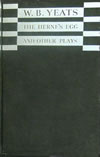
BL. W. B. Yeats
 |
39. The Herne’s Egg. London: Macmillan, 1938.
Of Yeats’s drama written after his encounter with the nô, this work, which may be seen as a dramatised working through of the philosophical system codified in A Vision (38), is the least derivative of, and the least like in its effect, the classical Japanese theatre. The chorus of attendants, masks, much of the minimalism, and the focus on the re-lived passions of the dead are dispensed with. Mime, ritualised movement, and anti-representational stage properties remain central, but these are as much the devices of European Symbolist and Expressionist drama as of the nô, and so a direct link between the Japanese form and the dramaturgy here would be difficult to argue. Even those critics most inclined to find lessons from the nô behind Yeats’s middle- and late-drama have reserved comment, or have written of ‘assimilation’ rather than of ‘influence’: see especially 149 and 180, and also 44b and 98.

